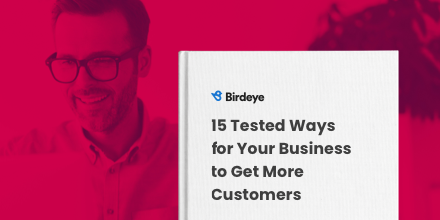If you’ve ever struggled with figuring out how to price your products, you’re not alone. Many business owners don’t know how to price their products or services. But thankfully, there are several examples of pricing strategies you can leverage.
Not taking a strategic approach to price brings many problems, including missed opportunities and lost revenue. A well-thought-out pricing strategy can boost revenue and influence consumer behavior and market positioning.
Looking for a quick answer? Your pricing strategy shapes your business' path to profitability and market positioning. An effective pricing strategy aligns with business goals and ensures a product or service's perceived value in the market.
Read our detailed guide on how to delete Google reviews or skip to the desired sections:
Table of contents
- What is a pricing strategy?
- 11 most common pricing strategy examples
- The formula for a winning pricing strategy
- Steps to conduct a pricing analysis
- Real-life examples of pricing strategies
- Frequently asked questions about pricing strategy
- Empower your business by implementing these examples of pricing strategies
What is a pricing strategy?
A pricing strategy is a well-thought-out plan that determines how a business sets the prices of its products or services. It has various objectives, such as maximizing profits, gaining market share, or creating a perception of value.
Your pricing strategy isn’t merely about covering costs; it’s about positioning your brand in the market and staying competitive. It influences customer’s purchasing behavior and business profitability.
11 most common pricing strategy examples
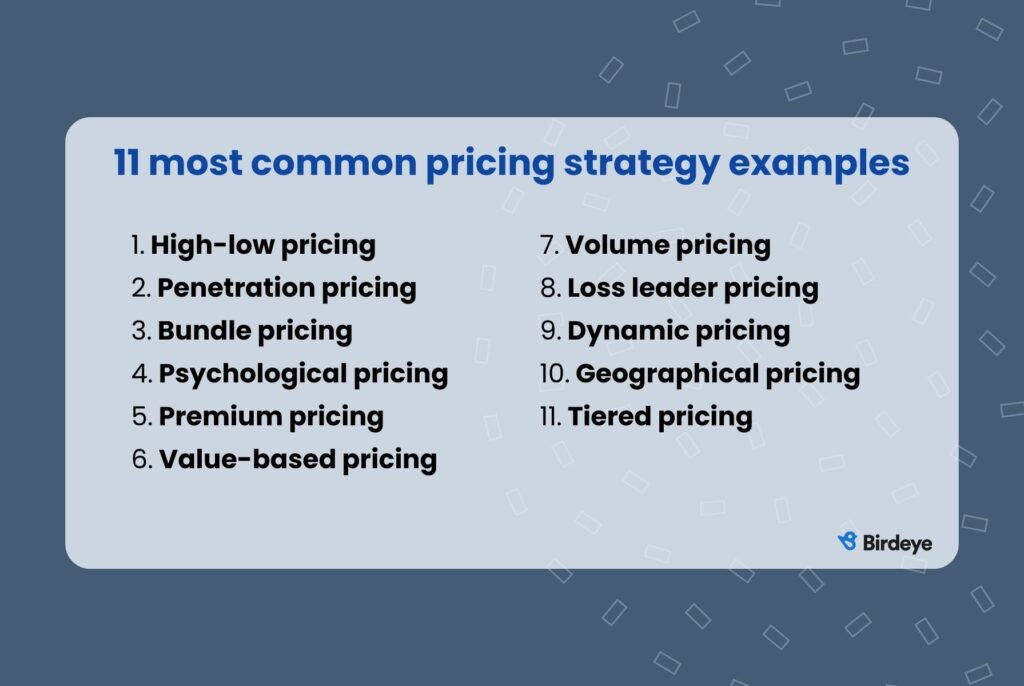
Pricing strategy is not a one-size-fits-all concept; it’s a dynamic approach to setting the price of your products or services to achieve specific business goals. Here are the 11 most common pricing strategies:
- Price skimming
- Penetration pricing
- Bundle pricing
- Psychological pricing
- Premium pricing
- Value-based pricing
- Volume pricing
- Loss leader pricing
- Dynamic pricing
- Geographical pricing
- Tiered pricing
1. High-low pricing
High-low pricing is a common pricing practice and is also known as price skimming. This strategy, especially popular in consumer electronics, involves charging a higher price for a product that is either new to the market or of superior quality to other products.
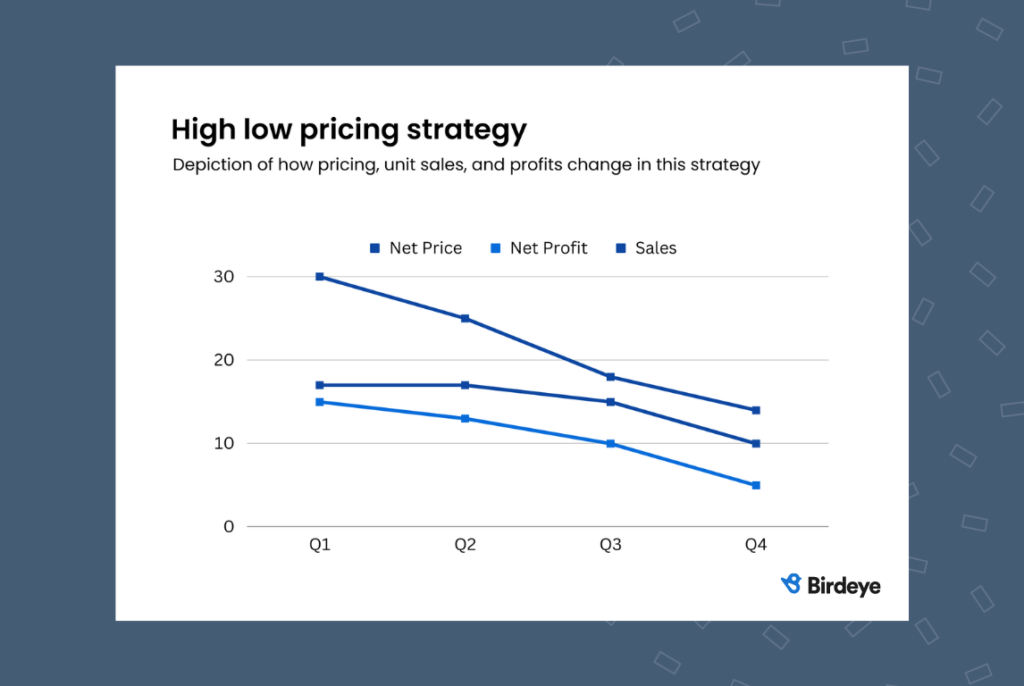
Let’s consider smartphones, gaming consoles, and video games. When a brand introduces a product, the price is usually high. As the hype dies down, new products come in, technologies become outdated, and prices fall.
High-low pricing is especially effective when little data shows how to price your products and services.
This pricing model will help you maximize profit, as excitement levels and sales are usually at their highest when introducing a new offer/product. As the price goes down, your profitability will decrease, though your product sales remain decent even many years after launch.
2. Penetration pricing
Penetration pricing strategy involves setting low prices to gain market share and increase sales quickly. It is the opposite of price skimming because, at some point, you will need to raise prices to ensure your business can continue to grow.
This makes it to the list of great pricing strategies examples, as it boosts brand recognition and establishes your business in the market by getting an initial burst of sales.
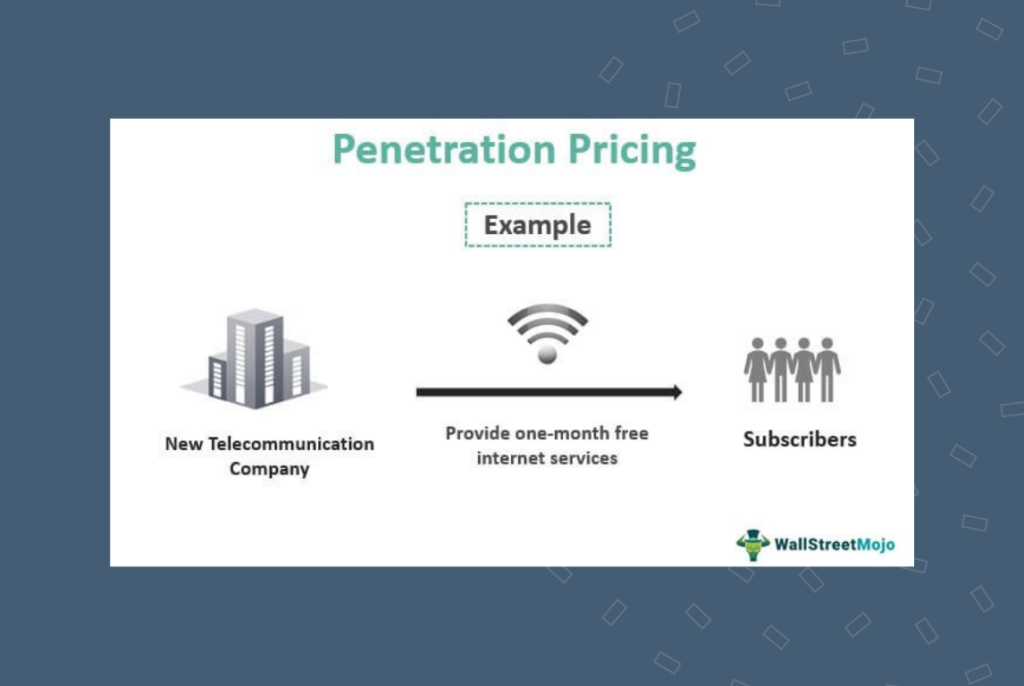
The downside to the penetration pricing strategy is that, at some point, you will need to raise prices to ensure your business can continue to grow.
So, while you may acquire many customers initially with this pricing strategy, you will need to work harder to retain them when you raise prices to increase profitability.
3. Bundle pricing
Bundle pricing involves offering several items at a discounted price when purchased together, encouraging customers to buy more than one item.
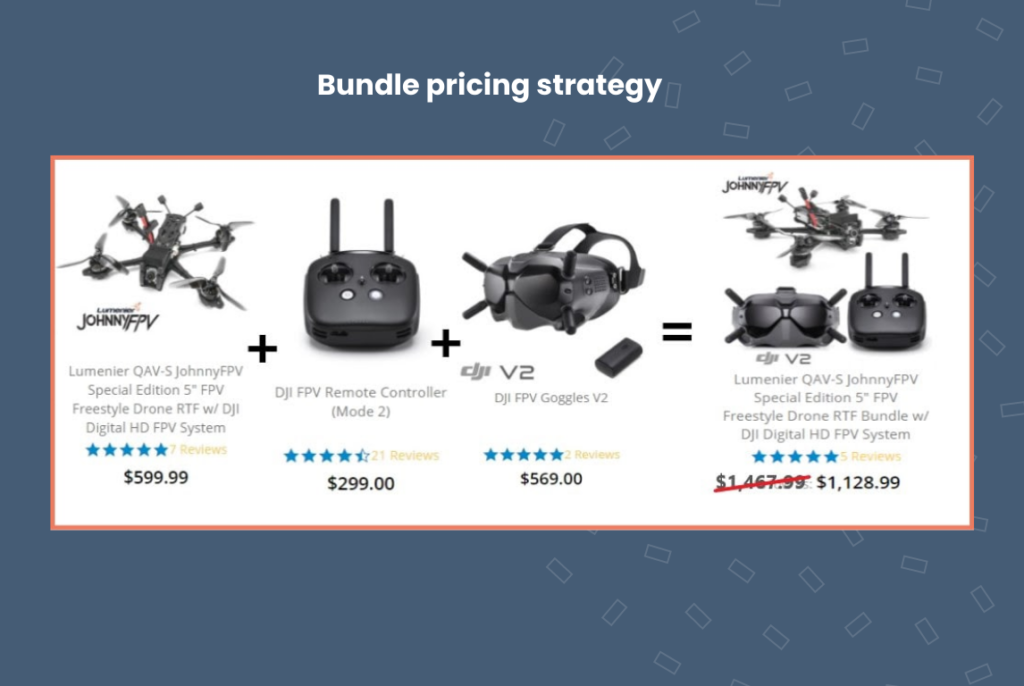
This falls under the good pricing strategy examples because it encourages upselling and can enhance the perceived value of the offerings.
In this model, businesses plan on selling two or more complementary products in a package that costs less than they would individually. Discounts motivate customers to buy more because the perceived value of the bundle is higher.
For instance, telecommunications companies will bundle cable internet and TV services together to motivate customers to become long-term subscribers. There may be some short-term savings for the customer, but they usually pay a higher price for both subscriptions in the long run.
Bundle pricing can help increase order sizes, simplify customer buying decisions, and move product stock you’re having trouble selling.
4. Psychological pricing
This is the most widely used pricing strategy examples modern companies use as these techniques rely on psychological factors such as discounts and common industrial reference points. Studies have shown that consumers generally don’t know what something is supposed to cost.
We usually compare the price of the product we’re thinking about buying to other similar products. Or, we buy something on sale to make ourselves feel better about the purchase.
Psychological pricing works because consumers feel they’re getting the best possible deal, which may not always be true.
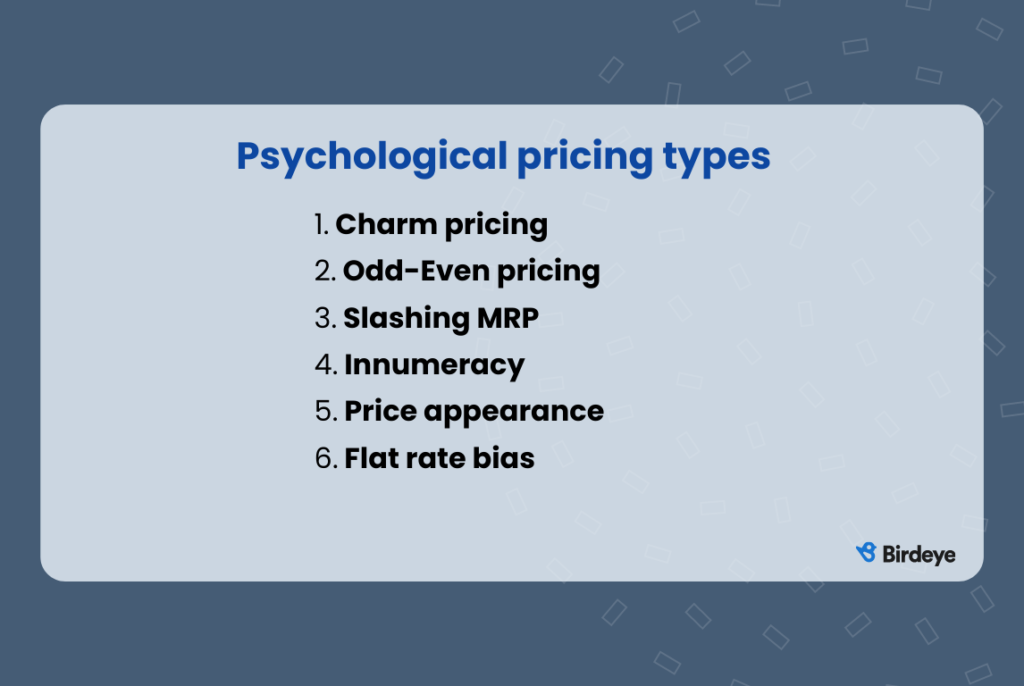
This is one of the companies’ most preferred pricing strategy examples because it is emotionally driven to make consumers buy. A few tactics used are:
- Charm pricing. End the price in .99. If a product costing $4 is priced at $3.99, for example, the psychological effect is that it costs $3 rather than $4.
- Odd-even pricing. Similar to charm pricing, based on the idea that customers purchase products with prices ending in an odd number. $129, $67, and so on.
- Slashing MSRP. Slashed prices give customers the impression that they are saving money on a product. This pricing strategy is common in the automotive industry but is also frequently used in other markets.
- Innumeracy. It’s hard to tell the difference between 50% off and “buy one get one free.” Even if customers would save money with the 50% off offer, they will often buy one to get one free instead.
- Price appearance. Shorter numbers tend to work better. $12 looks cheaper than $12.00 even though it’s the same price.
- Flat rate bias. An all-inclusive vacation may cost $2,000. A consumer may be able to save money booking flights and lodging on their own, but because they prefer flat rates, they will book the all-inclusive package instead.
5. Premium pricing
In this strategy, businesses set high prices in order to appeal to buyers who value prestige and exclusivity over cost savings.
The premium pricing strategy requires that you create the perception of luxury and prestige using marketing and brand positioning strategies. Your brand must exude opulence to appeal to the wealthy, even if your products are only marginally better than more affordable alternatives.
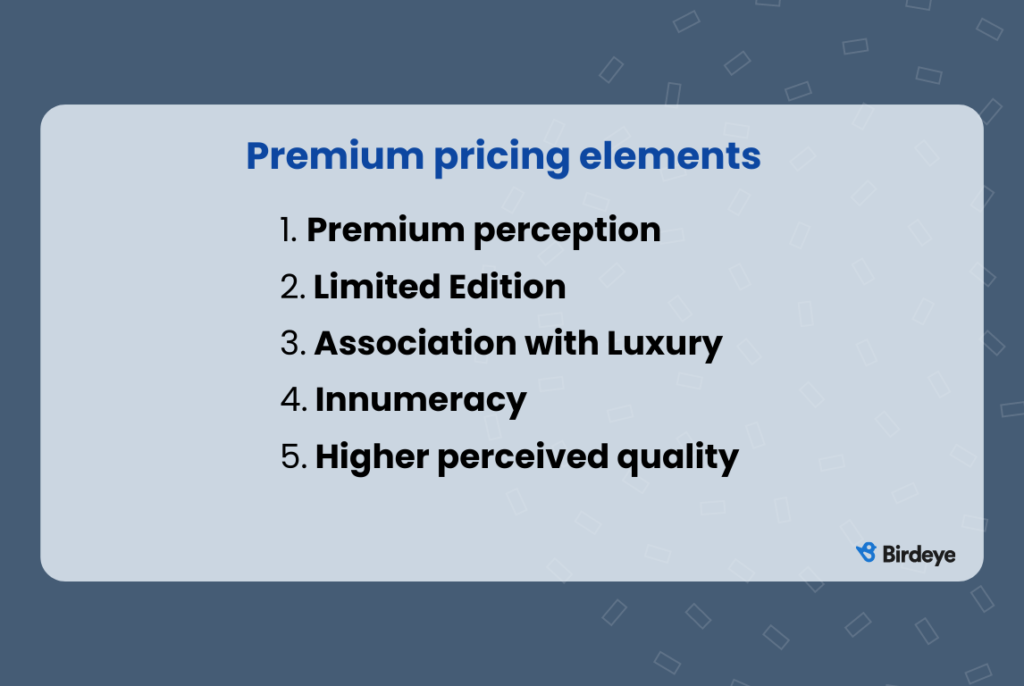
The Romanée-Conti is one of the most expensive bottles of wine ever sold. It’s unimaginable to some, but companies selling to the affluent know well that their target demographic is willing to spend over $550,000 on a bottle of wine.
Some premium pricing brands include Indochino in fine clothing, Rolex in premium accessories, and Bugatti in luxury vehicles.
Scroll below to read more pricing strategies with examples.
6. Value-based pricing
This strategy sets prices based on customer-perceived value rather than actual production costs.
Value-based pricing relies on customer research and, in some cases, focus groups. To price your products at a level, your customers are willing to pay, you must become intimately familiar with how they perceive your value.
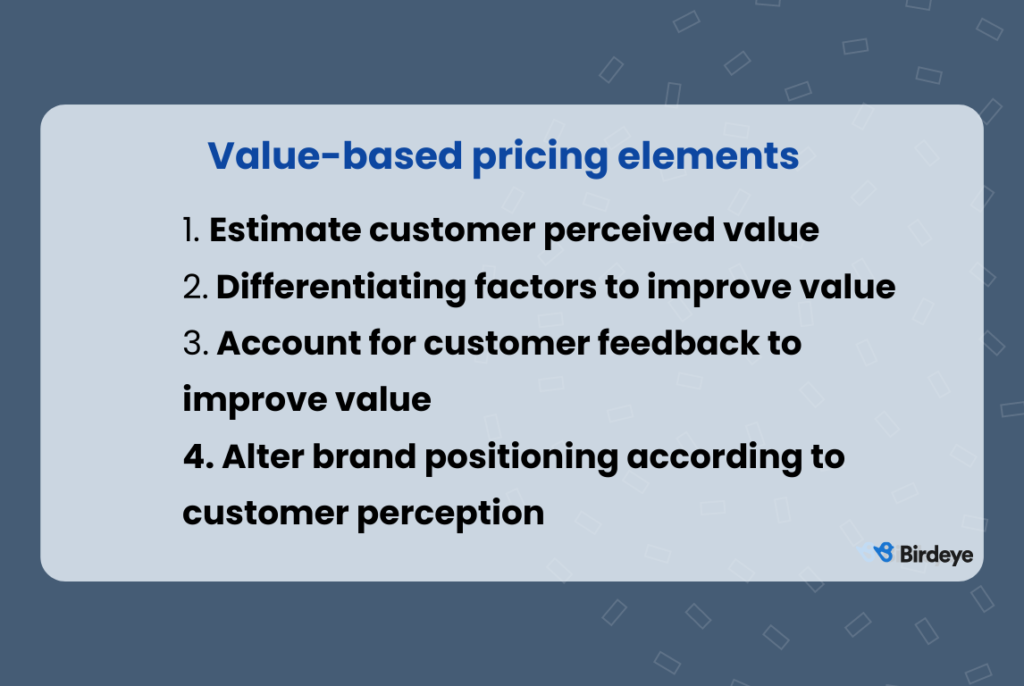
What differentiates these pricing policies examples from others is that value-based pricing focuses on the benefits and solutions the offering provides rather than production costs. The consumers are mainly luxurious and not very price-sensitive.
Value-based pricing is often used to market luxury fashion items and everyday essentials like milk. “You pay more for the brand” is a common phrase among consumers.
There’s a difference between Gymshark and Nike, for instance. There may not be much of a gap between the quality of their products, but Nike’s prices are higher because consumers perceive Nike products to be of a higher value.
7. Volume pricing
Volume pricing is among those examples of pricing strategies that offer discounts to customers that purchase more than a certain amount of goods or services, such as bulk orders of 50% off for purchases over $500.
This strategy can help companies appeal to a wider base of customers, offer competitive pricing, and sell more of their products. This pricing model is quite common in big box stores, including stationery and office supply businesses.
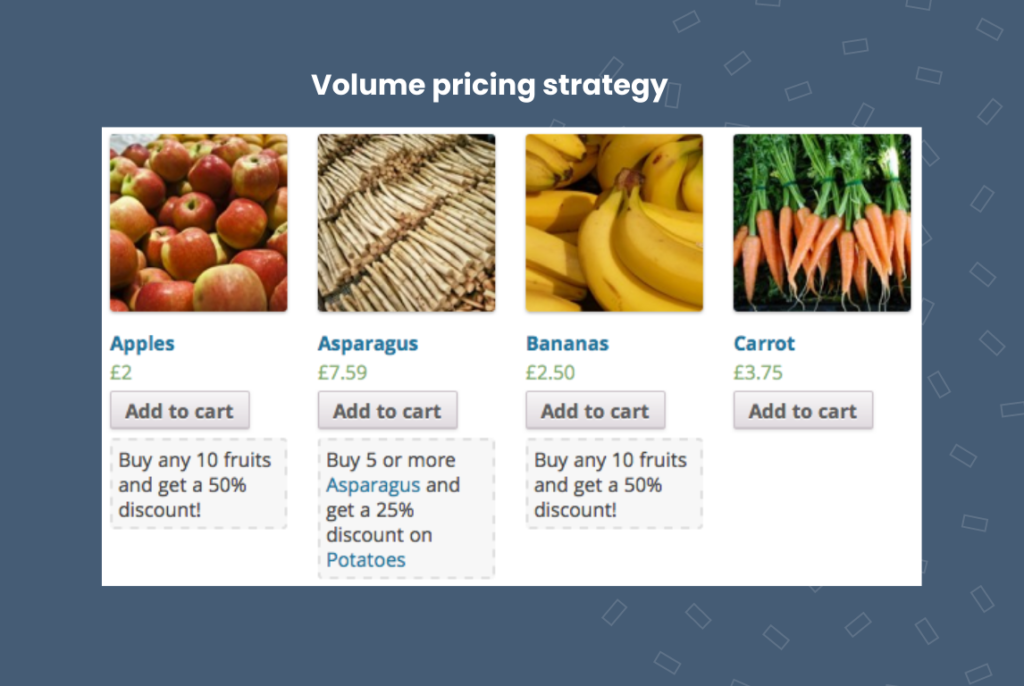
The main downside of volume pricing is that your customers may continue to expect lower prices even after you’ve stopped offering volume discounts.
Master the Art of Pricing Strategy That Brings Profits
Want to see the impact of Birdeye on your business? Watch the Free Demo Now.
8. Loss leader pricing
This strategy sets lower prices on certain items in order to attract customers who will then purchase additional items at full price. Companies will often use loss leader pricing strategies when entering a new market or are interested in boosting their market share.
Did you know Microsoft does not make any money on Xbox consoles? They sell them as a loss leader. The money is made on peripherals and most video games on the backend.
Another example is the information technology company HP. They sold some of their printer models for $24.99. What may have appeared as an especially attractive Black Friday Deal was strategic.
These are very clever pricing strategies examples, and you can use them based on your business.
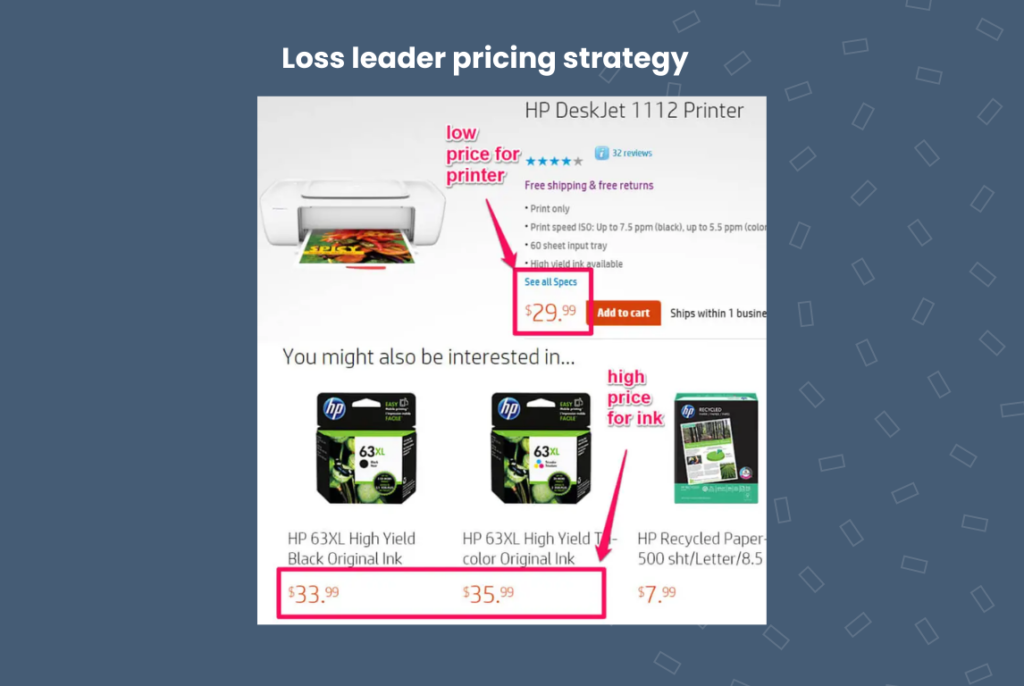
HP knew buyers would need ink refills, and the company sold a two-pack of HP ink cartridges for $30. Over the long term, HP knew they would more than recoup their printer costs.
9. Dynamic pricing
This strategy sets variable prices that change according to demand, competition, and other real-time factors to maximize profits.
Dynamic pricing helps businesses adapt to changing circumstances, be it market conditions, inflation, competition, or otherwise.
Hotels often use dynamic pricing to adjust the price of rooms depending on availability or seasonality, ensuring that they’ve booked out as much inventory as possible.
While it is a good idea for businesses to adjust their prices periodically to ensure profitability, changing too often can backfire on prospects and customers.
Being too dynamic with your pricing has its downside, especially if your customers develop expectations around how much your offers cost and they constantly see it fluctuating.
10. Geographical pricing
What makes this pricing strategy ranked among the top 11 pricing strategies with examples is that companies can maximize their profitability with geographic pricing practices – selling goods and services at prices the market expects or tolerates.
Businesses offer different prices depending on geographic location in order to account for the differences in shipping costs or local economic conditions.
Companies can also be more agile in adapting to varying tax requirements, shipping costs, wealthier customer demographics, and more.
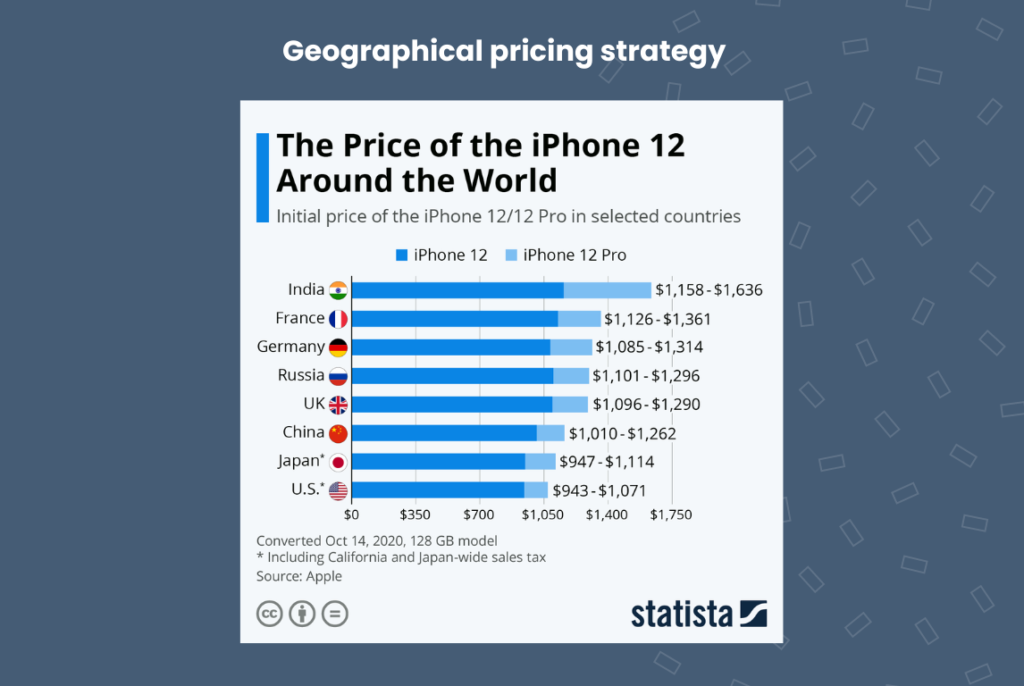
Geographical pricing is significant for companies with a global customer base. While companies with a regional or national customer base may adopt geographical pricing, this strategy doesn’t usually add significant value to them.
11. Tiered pricing
This type of pricing is among those examples of pricing strategies that offer several product/service packages with different options at various price points so customers can choose the package that best meets their needs and budget.
Tiered pricing is especially common with SaaS businesses. This pricing strategy allows companies to appeal to a broader base of customers, offering solutions at different price points with different features matched to different target personas.
It should not be confused with bundle pricing though.
It’s not a requirement, however, that you sell subscriptions. If you sell widgets, licenses, or tickets, the tiered-pricing strategy is a good implementation approach.
The primary goal behind this strategy is to increase customer retention and maximize customer lifetime value, so you must work hard to ensure your customers are happy with your service long term.
The formula for a winning pricing strategy
Now that you’ve read all the top pricing strategies with examples, you’d want to understand what’s the winning strategy to nail the pricing of your product. Find them below:
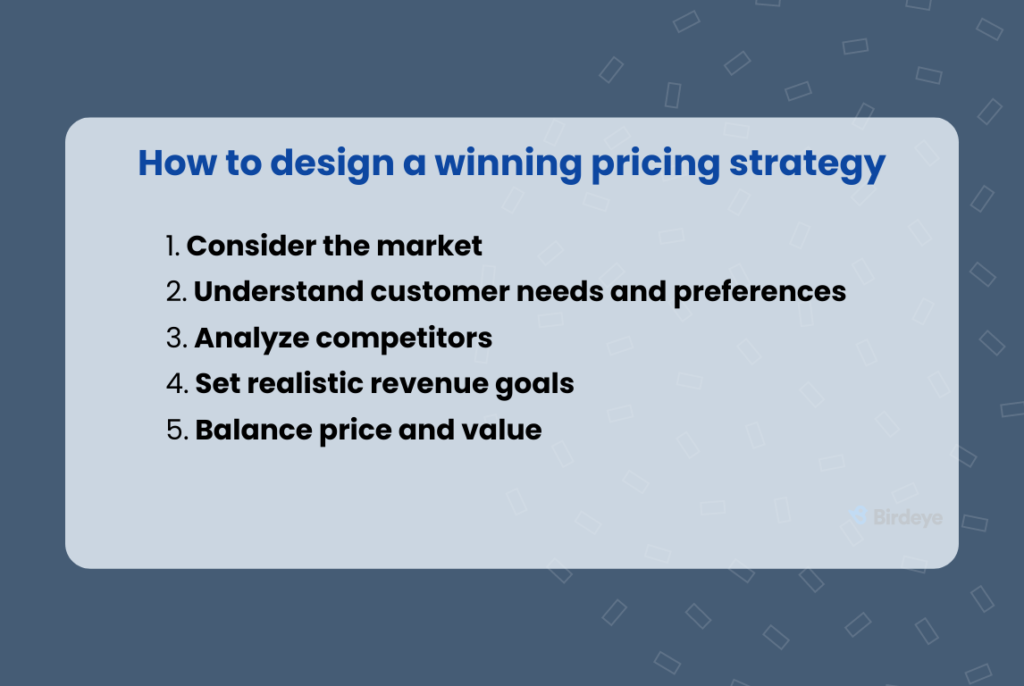
Considering the market
Identify your competitors and competing products, your customers, and underserved markets, if there are any. Consider where your product or service would play best.
Having a constant finger on the market’s pulse will help you create timely and relevant offers, which is the cornerstone of effective pricing strategies.
Understanding customer needs and preferences
Your competitors’ customers may not always be your customers. Any of the examples of pricing strategies will not work unless you understand what your customers need.
It’s important to know your target customer base completely – from demographic data and their psychological reactions to your products. Start by understanding your customers’ interests, goals, values, and desires.
Analyzing competitors
Competitive analysis plays an important role in pricing strategy. Many businesses price their products similarly to their competitors, but this doesn’t always work. It can create the perception that your product is the same as what’s already out there.
If you want to be disruptive and gain market share, you may try pricing your products cheaper than your competitors. If you want to market to the affluent, you may want to create the perception of luxury by charging a much higher price.
Competitor analysis is especially useful because you can uncover what your competitors are not doing.
Setting realistic revenue goals
All companies have revenue goals to meet. Setting realistic revenue targets ensures that you have a clear pathway for meeting these objectives.
“Realistic” is the keyword in all the pricing strategies with examples you’ve read because it’s easy to make rosy predictions that won’t come true. But you need time to think strategically about how your goals will be met promptly.
Balancing price and value
You don’t want your customers to feel cheated. If they’re buying a $50 razor, they want to feel like they’re buying a $50 razor, not a $10 one. Selling a product that doesn’t meet customer expectations can harm your reputation and impact revenue.
Just in the pricing strategies examples about bundle pricing mentioned above, you must properly balance the real and perceived value.
This will boost your brand’s credibility and position strategically in the market.
Steps to conduct a pricing analysis
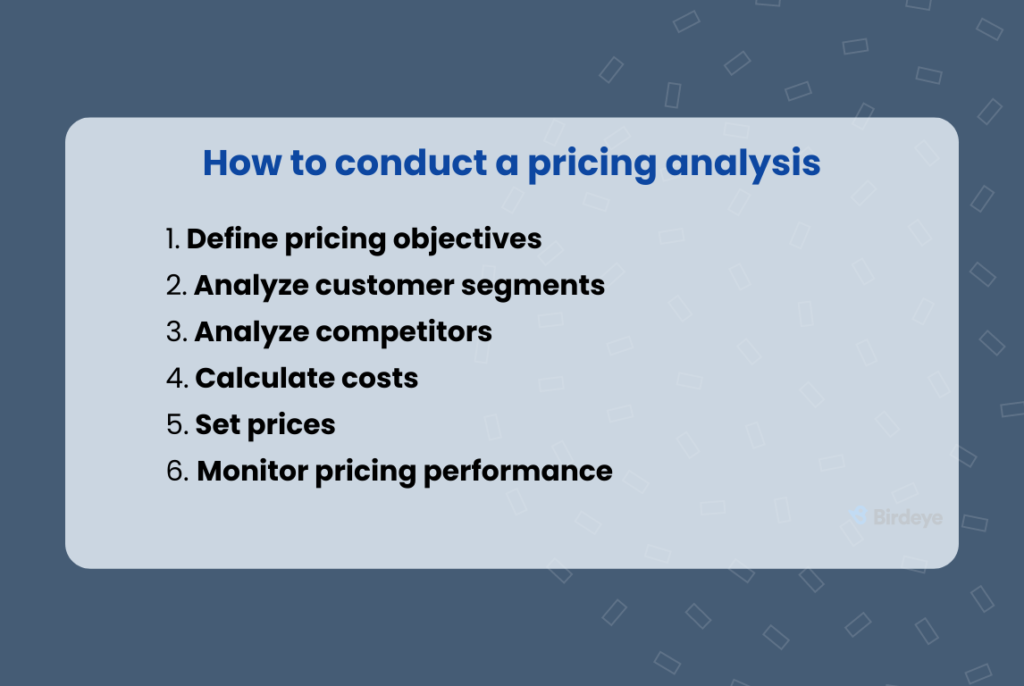
Define pricing objectives
Establish your goals and determine how pricing should contribute to meeting them.
It’s essential to determine your revenue goals to identify how you can reach them with your product or service. You may also consider other goals such as market disruption, increasing market share, launching into a new region, etc.
Analyze customer segments
Understand the different types of customers you have, their preferences, and price sensitivities, and prioritize segments for analysis.
Companies often like to think they only serve one type of customer, but this is rarely the case. Different types of people are coming to your business looking for specific solutions.
You must identify who these prospects and customers are so that you can cater to these segments effectively. Offering different solutions to different customer segments is a great way to increase your revenue.
Analyze competitors
Examine competitors’ prices to understand where your prices fit in the marketplace and identify any discrepancies or opportunities for improvement.
Analyzing your competitors will help you understand where you fit into the market.
Start by collating a thorough list of competitors and how their products are priced. Analyze what they offer relative to your product to identify your pricing strategy’s pros and cons.
For instance, you may find a competitor who is charging less for more features. This information can help you determine your strategy moving forward.
Most importantly, though, doing competitive research can help you uncover opportunities and underserved needs/markets.
Calculate costs
Identify direct and indirect costs associated with production, delivery, and support activities. These could be overhead expenses, labor costs, and marketing investments, which should be factored into price calculations.
As highlighted in pricing strategies with examples mentioned above, businesses often assume if they sell more, they will make more. This isn’t always true. There is almost always a cost associated with producing more, like customer support, labor, and marketing, that needs to be accounted for.
If you don’t factor expenses into the equation and are met with explosive demand, you can lose money.
Set prices
Determine the most suitable pricing models for each segment (e.g., discounts, membership plans,) taking into account all relevant factors, including customer preferences, market conditions, cost structure, as well as financial goals and objectives.
One pricing strategy may be enough for certain products. Others may require multiple pricing strategies to ensure success in the market. At this stage, you must consider the most suitable pricing strategies for your new offer based on everything you know about your goals, the market, your customers, and your competitors.
Monitor pricing performance
Track changes in demand over time to identify any potential issues with the current pricing strategy and adjust accordingly.
Setting a price is rarely a “set and forget” exercise. You must track the performance of your offers over a period, noting changes in the market, sales figures, and projections.
There will likely be a time when you need to adjust prices, and it is better to be prepared.
Real-life examples of pricing strategies
So, let’s dive into some real-life examples of pricing strategies that popular companies use:
- Volume pricing by Costco
- Bundle pricing by Verizon
- Premium Pricing by Rolex
Costco is known for offering large quantities of groceries, consumer electronics, and everyday goods at low prices. This is the essence of volume pricing, selling products in bulk and offering discounts on them.
The secret to Costco’s success is that while its products may appear cheaper to the average consumer, a margin is built into their prices. By moving large product volumes and selling memberships, Costco maximizes profitability.
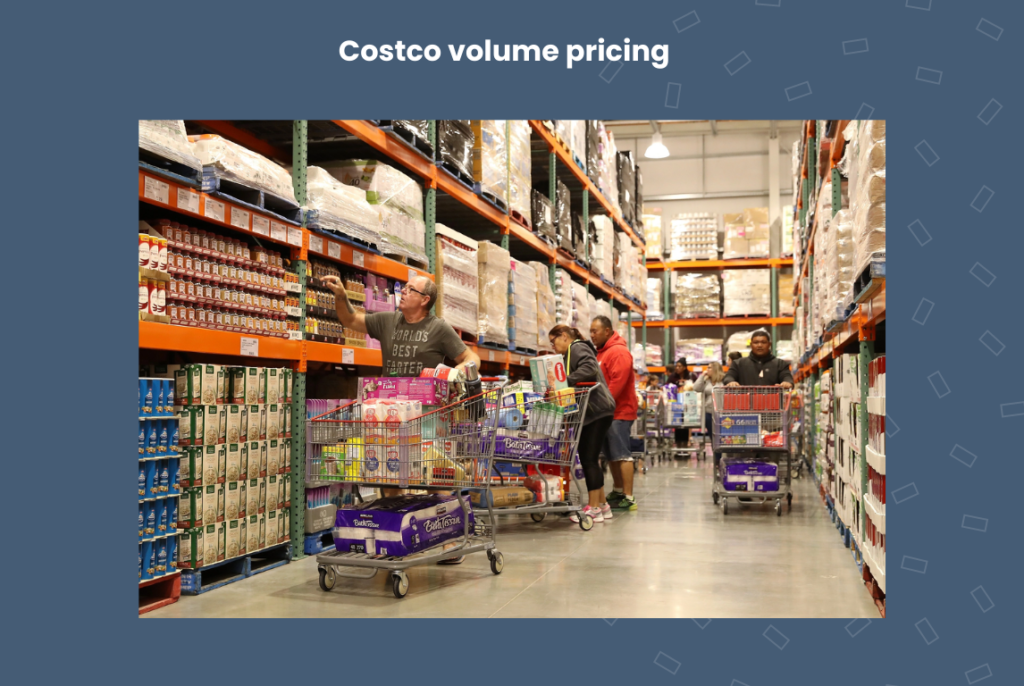
Bundle pricing by Verizon
As with many telecommunications companies, Verizon relies heavily on bundle pricing to drive business. For instance, they bundle their Fios Internet and TV services to entice customers to commit to a more comprehensive home entertainment package.
The Verizon internet and TV packages may include other extras to sweeten the deal, like an Xbox console, controller, headset, or Home Depot gift card.
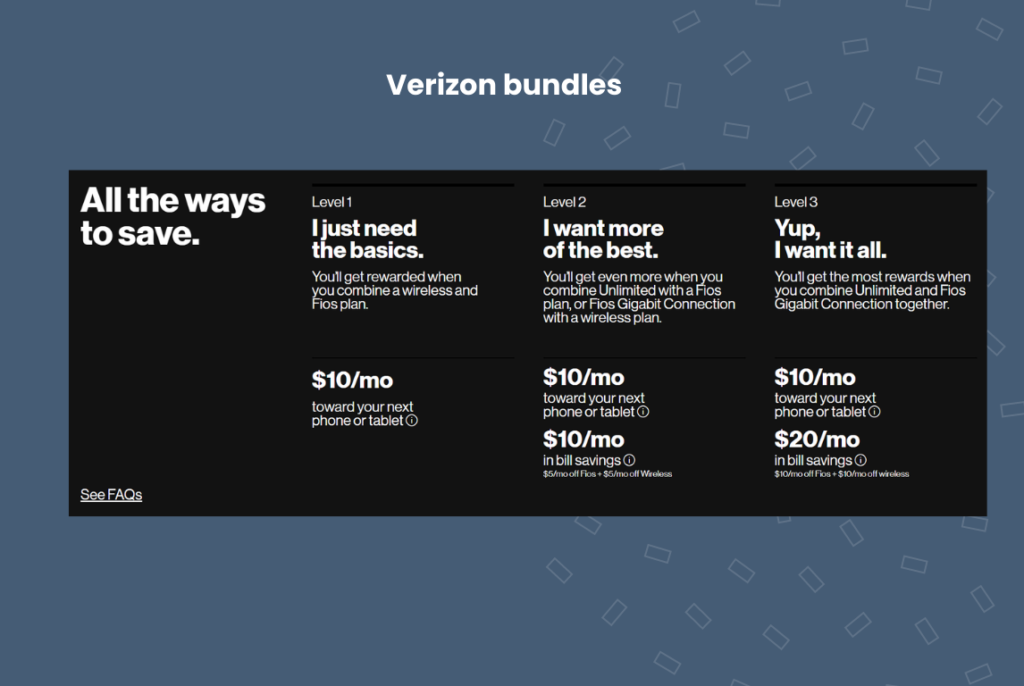
Premium Pricing by Rolex
Rolex is the very definition of a luxury watch band. Their name is practically synonymous with affluence. It’s not hard to find a cheaper watch, but the status and feeling that comes with owning and wearing a Rolex is what consumers are after.
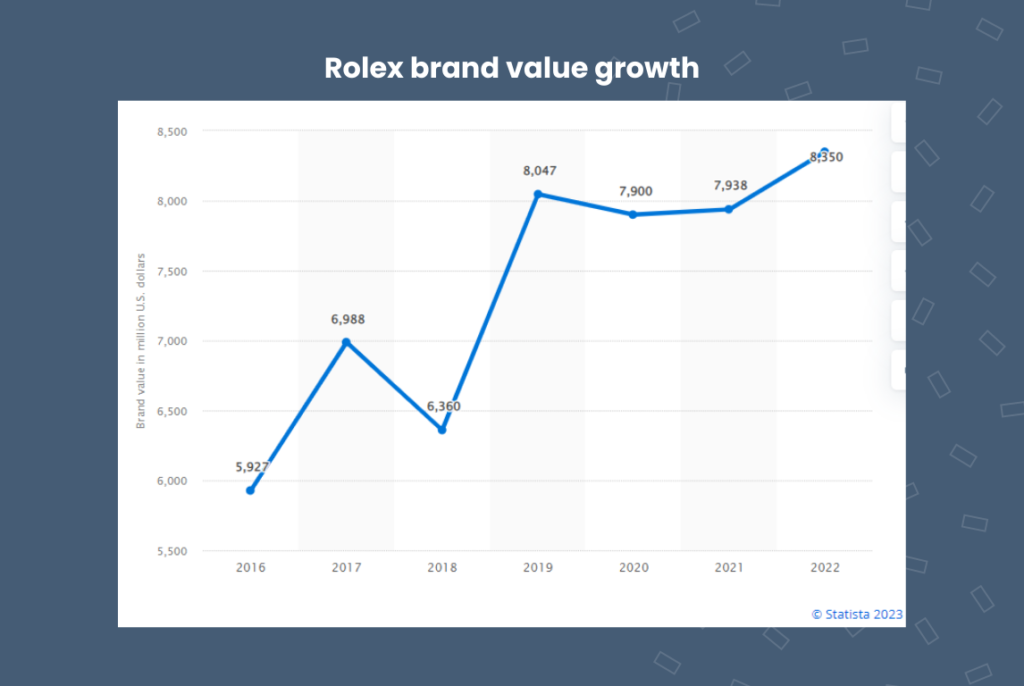
By selling to the affluent, Rolex is effectively polarizing the market and appealing only to a specific type of customer they want to serve. The strategy works as we know how Popular Rolex is.
Frequently asked questions about pricing strategy
Pricing strategy is the method businesses employ to price their offerings in a way that appeals to their customers, is competitive, and sustains the business in the long run.
The three basic pricing strategies are cost-based pricing, value-based pricing, and competition-based pricing. They focus on different aspects to help businesses make the right decision.
Companies use a variety of pricing strategies on a per-product basis. They explore factors like market conditions, customer needs, competitors, revenue goals, and price/value fit to determine the ideal pricing model.
A high-low pricing strategy allows companies to collect customer data while selling their product at a higher-than-normal price point. This maximizes profitability.
Psychological pricing might be seen as manipulative, but as long as it is transparent and not deceiving, it is considered an ethical strategy.
Empower your business by implementing these examples of pricing strategies
Regarding pricing, you shouldn’t just pull a number out of a hat and call it a day. That’s not a strategy. Pricing strategy must rely on facts and figures that guide you in the right direction.
Consider all these pricing strategies examples after conducting an analysis of the market, customers, competitors, and other factors that empowers your decision-making.

Originally published

